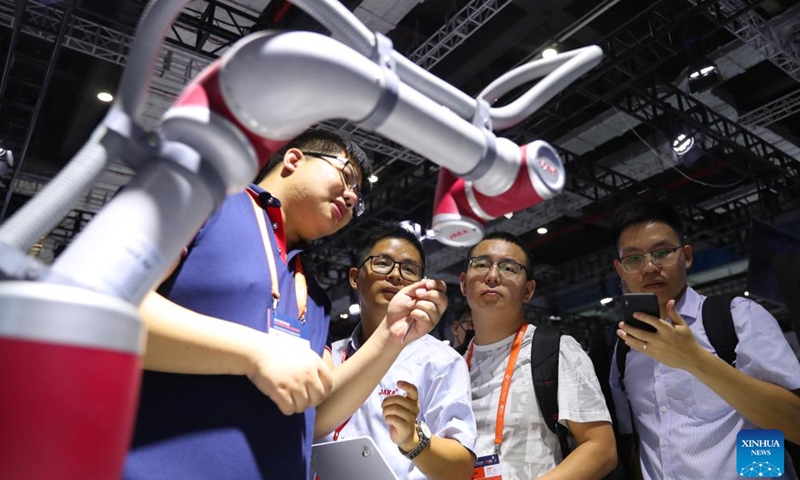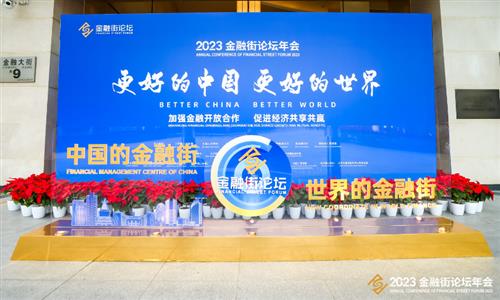China's economy to thrive with implementation of robust macro policies
Healthy recovery remains intact

A staff member talks with visitors beside a robot during the 23rd China International Industry Fair in Shanghai, September 19, 2023. Photo: Xinhua
The Ministry of Industry and Information Technology on Monday released guidelines to improve the public service system for small and medium-sized enterprises (SMEs).
Analysts said the move is the latest example of the authorities' support and will inject new momentum into China's economic recovery and high-quality growth. The country also posted on Monday better-than-expected credit data for October.
SMEs will experience higher satisfaction and benefit from a strong public service system by 2035, according to the guidelines. The SME public service system will be more comprehensive, with an optimized layout, enhanced intelligent platforms, improved services, efficient resource utilization, increased service capabilities and guaranteed quality.
The move marks the latest policy support by the Chinese authorities to stabilize expectations, boost domestic demand and promote the economic recovery since a key meeting in July.
With the implementation of these policies, experts said that major economic indicators continued to improve in October, adding momentum to China's economic recovery.
Chinese banks extended 738.4 billion yuan ($101.30 billion) in new yuan loans in October, an increase of 105.8 billion yuan from the same period last year. The reading exceeded market expectations of 600-650 billion yuan.
Zhou Maohua, an economist with China Everbright Bank, told the Global Times on Monday that the October credit and total social financing data exceeded market expectations, showing strong momentum.
"The financial data reflected a sustained recovery in domestic demand and boosted market confidence in the prospects of an economic recovery," Zhou said.
Considering the various factors affecting year-end funding, it is possible for the central bank to implement reserve requirement ratio cuts and other structural tools to support weak areas in the real economy and key emerging sectors, Zhou said.
The National Bureau of Statistics is set to release economic data for October on Wednesday, including industrial output, fixed-asset investment and retail sales.
Market observers believe the data will show a general rebound in year-on-year growth rates, with consumer demand boosted by the holiday season.
A study by CITIC Securities said that the combined effect of the Mid-Autumn Festival and the National Day holidays drove strong growth in retail sales in October, with a year-on-year rise of about 7.9 percent.
According to the Ministry of Culture and Tourism, domestic tourism revenue during the eight-day holidays rose 129.5 percent year-on-year to 753.43 billion yuan. It was also up 1.5 percent from 2019.
The China Center for Economic Research under Peking University estimated that fixed-asset investment grew 3.3 percent year-on-year from January to October, up 0.2 percentage points from January to September, as the issuance of trillion-yuan scale special-purpose government bonds and domestic policies drove long-term investment.
Macro policies took effect last month, domestic demand was released and international cooperation recovered - a for example, the holding of the China International Import Expo from November 5 to 10.
Thus the economic recovery was sound, Chen Fengying, an economist and former director of the Institute of World Economic Studies at the China Institutes of Contemporary International Relations, told the Global Times on Monday.
"There is full confidence that China can achieve its GDP growth target of about 5 percent in 2023, and may even reach 5.4 percent," Chen said.
Experts slammed claims made by foreign media outlets that China's economy is slowing down or even contracting.
The recovery was stable in October and the uptrend will continue in the final two months of the year, Zhou Mi, a senior research fellow at the Chinese Academy of International Trade and Economic Cooperation, told the Global Times on Monday.
Consumption demand will continue to be released during the peak spending season, and exports of new-energy vehicles and batteries as well as the green economy are new growth points, Zhou said.
It is widely expected that China and the US could strengthen economic and trade ties during the APEC. This will also contribute to the steady recovery of both economies and the world as a whole, Zhou said.
China's economic growth will remain at a moderate rate for at least the next five to 10 years, Liu Shijin, former vice minister of the Development Research Center of the State Council, told the Global Times on the sidelines of the Financial Street Forum annual conference on Wednesday.
"To put the Chinese economy on the track of steady growth, it is crucial to tap new growth potential and release the current potential. China still has a lot of growth potential," he said.



